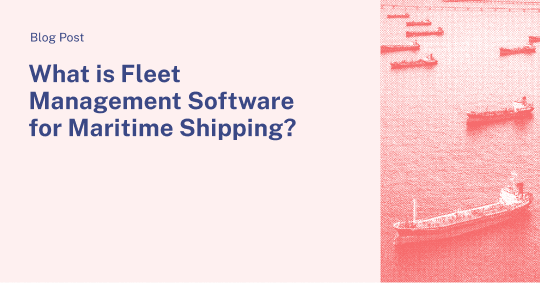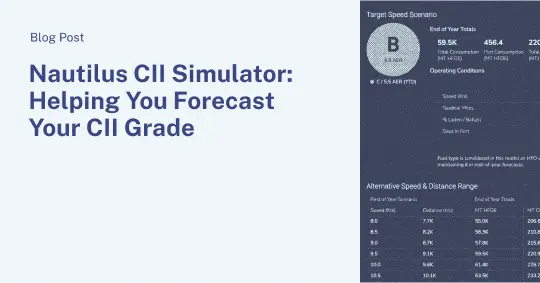So the bulk market is rebounding and high frequency data (HFD) is the new hot commodity in the maritime industry, as we covered in our last post. However, real-time vessel data on its own offers limited value without the proper analytics tools to make sense of it. In fact, just collecting HFD alone is not going to be the driver of meaningful value. It’s what you do with the data and how you manipulate it to extract actionable insights that delivers increased commercial returns to shipping owners, operators, and charterers.
We hear terms like “machine learning” and “data science” thrown around a lot in maritime shipping lately. It’s even something that we cited as a trend to look out for in 2018. And for many of the people we speak with, it’s not clear how to discern the value of this technology today, as it sounds more like the stuff of robot ships and artificial intelligence. So we wanted to take a moment to describe some tangible impacts machine learning can have on your shipping businesses today once you’ve embraced the value of HFD.
To start, it’s helpful to be clear about terminology. Machine learning refers to a computer using lots of data and specific algorithms to find some insight in that data or a relationship among different variables—a technology that, in a vacuum, may offer little practical value. Nautilus Labs employs a scientific approach to machine learning (a.k.a. data science) to validate the relationship that machine learning outputs. While machine learning is how an insight is discovered for a particular unique data system using some algorithm (e.g. cubic equations, neural networks, etc.), data science tests whether the insights from the machine learning algorithm are true in real life.
Machine learning to automate performance analysis and normalize for weather
But why should we trust machine learning as an accurate tool to facilitate vessel analytics? To start, traditional performance analysis is reactive, manual, and time-intensive. Moreover, it’s nearly impossible for humans to accurately analyze a vessel operating at sea. The ocean is not a “frictionless surface”, and a ship is constantly impacted by wind, current, and waves. Leveraging manual analysis to model the impact of physical forces on something as large and complex as a cargo vessel – each uniquely riveted and welded – is a nearly impossible task, particularly given all the other demands on shoreside teams’ time and attention.
To bring this to life, let’s imagine you have collected hundreds of variables every minute on a specific vessel: draft, power, RPM, torque, fuel flow, GPS position—you can even throw in a data point like the Captain’s name into the list of variables. Over the course of time, you collect millions of these data points, all of which correlate together in some way. Now imagine you wanted to determine who the Captain of the ship was at a given point in time during some voyage – machine learning allows you to use the computer-generated relationship between all these other variables together to predict who the Captain was and data science allows you to measure the accuracy of this prediction—this is a theoretical example, but you get the point.
Machine learning leverages a computer’s processing power to build a model that correlates what the relationship between different variables should be, given real-world inputs, and data science allows us to further validate that correlation with some quantitative measure of confidence. Nautilus Platform is successfully building vessel-specific machine learning models with a minimized error – typically between 3 to 4%—by automatically ingesting high frequency data to generate an accurate and comprehensive speed and consumption profile for a ship across all speed ranges.
But automating data analysis to create a real-time understanding of vessel performance is just half of the story. Even greater value lies in leveraging this technology to strip out the impact of weather, current, and waves on vessel performance retrospectively, mid-voyage, or, taking into account forecasted weather on predicted future performance of a vessel. Leveraging a database of hindcasted and forecasted meteorological and oceanographic data, we overlay weather conditions on top of each vessel’s custom model in order to normalize performance to either strip out the impact of historical weather or adjust it for forecasted weather. Taken a step further, an understanding of normalized vessel performance over time enables teams to analyze actual performance degradation and hull fouling.
For our clients, Nautilus Platform eliminates the time, difficulty, and complexity associated with assessing fleet efficiency but also outputs an accurate real-time depiction of vessel performance under any condition.
Machine learning as the basis for voyage optimization via Nautilus Platform
The machine learning models we have built for Nautilus enabled vessels using HFD are more accurate than any we’ve seen in the industry or maritime research. We are continuously working to refine our models and methodology, while adding more inputs which will even further improve their accuracy. Leveraging our proprietary algorithms overlaid with forecasted weather data and the ship’s planned route, we’ve been able to construct a voyage optimization calculator that our clients leverage to maximize daily TCE rate and profitability.
The long-term implications of voyage optimization are tremendous and machine learning-based performance analytics is the basis of it all. In our next post, we’ll explore how Nautilus Labs has unlocked profit opportunities for owners and operators in the form of speed instruction optimization. Ultimately, possessing the right tools to extract insights from an abundance of data leads to voyages that are optimized in real-time, and predictive vessel management that maximizes an owner operator’s return on each vessel.


